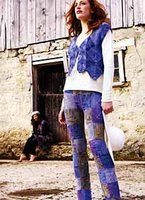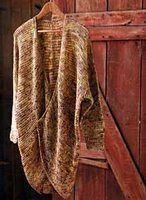I know there are some knitters who don't feel the Koigu love. Maybe it's one of those things where you either passionately love Koigu or you just don't get it, no middle ground. When it comes to Maie Landra's new book, Knits from a Painter's Palette: Modular Masterpieces in Handpainted Yarns

Knits from a Painter's Palette is a good-sized book, hardcover, and full of color photographs -- I mean, how could you do a Koigu book without zillions of color photographs? The endpapers show bins of luscious Koigu yarns and the pages are edged with close-up shots of Koigu strands. The book is wider than it is tall, and this works well, giving extra page width for the photos and diagrams of this visually striking yarn with plenty of white space to go easy on the eyes.
As for content, the book begins with an essay called "The World of Koigu," which tells about the background of Maie and Taiu Landra, discusses how Koigu came into being and describes how Koigu is created today. The next section contains some pointers for selecting Koigu colors, along with a "Stitch Workshop" that demonstrates Maie's modular techniques, including some photographs of shapes in various stages of knitting.The remainder of the book is devoted to patterns.
It's hard to generalize about the patterns. They aren't divided into sections, but rather are presented in a fairly random manner, one after another. The most significant thing they have in common is, of course, Koigu. But of the 22 patterns (some designs include multiple coordinating garments, like a matching stroller blanket and pillow, so there are actually patterns for more than 22 individual garments in the book), you might break them down this way: 4 shawls/wraps, 1 poncho, 4 vests, a baby blanket and pillow combination, a "cloak," 3 jackets, 2 dresses, a cardigan in both adult and children's sizes, 2 skirts, 2 scarves, 3 sweaters and a tunic. Oh yeah, and some pants.

Another way to sort out the patterns is by method of construction: there are about 5 or so lace patterns (and I’m using the term “lace” very loosely, to include simple patterns knit on large needles), about 4 or so sweaters knit in the traditional fashion, about two garments knit in strips that are sewn together; the rest – the majority of designs in the book -- are knit modularly. This is a pretty unusual and significant consideration, since there are knitters who simply don’t care for modular construction.

Koigu aficionados will note that some of the patterns have previously been released: the well-known Charlotte's Web Shawl, for example. If you are buying this book solely for the patterns, you'll want to skim through to make sure you don't already have the patterns you're most interested in.
A further note on the patterns: I have heard mixed reviews from knitters about the garments featured in the book. Many of the patterns are boxy and flowing; they tend not to have the body-hugging shaping that is now in style.

This is largely (but not totally) a function of the modular techniques used. If you have no interest in flowing jackets or vests, boxy fit, dropped shoulder, though, caveat emptor. If the dreaded butt sag makes you leery about knitted pants or skirts or dresses, again, buyer beware. The signature style of the Koigu ladies is what it is and creates garments that are as much works of art as they are pieces of clothing. If their style isn’t yours, don’t be disappointed if you don’t knit some or most of the garments in this book.
From a technical standpoint, everything looks in tip-top shape. The printing is easy to read, there are many color photos, there are detailed diagrams (some in color) showing the modular construction methods, measurements are given, and colorways are even identified by the trademark Koigu number. Many of the patterns come in one size, but the sizing is so generous and, well, flowing that this shouldn’t present a problem for the vast range of female figures, although the tiniest and slimmest may be overwhelmed by the amount of fabric that will swirl around them.
Last, I would be remiss if I didn’t try to express the “eye candy” aspect of this book. If you love handpainted yarns, Koigu in particular, just browsing through the book is inspirational. To see that many garments showing off to perfection the many hues of Koigu makes me happy. Considering different methods of construction, unusual combinations of multicolors, the mixing of shape and color, solids and multicolors, inspires me. And having met the Koigu ladies a few times, learning about their lives and their home and their art though this book makes me feel a connection to them.
As my husband would say, this book is the functional equivalent of pornography for knitters. And after seeing the glazed look in my eyes after I leafed through it for the first time, and wiping the drool off the coffee table, he should know.

I once had a chance to travel to the farm where the Koigu ladies have their workshop. They were both lovely and spent a good four hours with my mom and I talking about the yarn, their patterns, and their techniques. It was a wonderful afternoon and cemented my love for Koigu. agree that their book is absolutely beautiful even though the garments are not my personal style.
ReplyDeleteThanks for the review!
ReplyDeleteThanks for the review!
ReplyDeleteGreat review! My copy beat me home from TNNA. I didn't get home 'til Tuesday, and UPS delivered it on Monday. Everything I brought home from TNNA was ignored while I sat and read it through like one would a novel.
ReplyDeleteI haven't had a chance to see the book yet, but I agree with the "eye candy" thing. A book full of Koigu? Oh yea- gotta get that...
ReplyDeleteI have always been a huge fan of Koigu, and one day, I'll make the trek with Kathy up to the North Border Marches and check out this little land of ahhhs. But I have never been impressed with the Koigu ladies' ability to design with their own yarn.
ReplyDeleteIn fact, as odd as it sounds, I don't think they're very good at mixing their own multi's to their best advantage.
I've done a lot of designing with Koigu, and love the effects I can get from it. And even though I may need to own this new book, just for the sake of owning it, I don't think I will ever appreciated their design capabilities.
Oooh, Joe, Kathy's gonna open up a can of some whup-ass if you talk like that.
ReplyDeleteI'm dying/dyeing to go too. Did you see that we'll now need passports to go to Canada? Or did I read that news story wrong?
wait, am i reading this right? there's no SOCK patterns???
ReplyDeleteas much as i might want to wrap myself in a garment that takes 20 skeins of koigu, the designs don't sound very practical to me.
Unfortunately, despite being contacted by agents, the Koigu ladies don't seem very interested in exporting to Aus. It's hard to explain to people how excellent Koigu is when they can't see or feel it. I have a jealously guarded stash from a visit to the US in 2000.
ReplyDeletem-h, you know any of us would send you koigu if you ever needed a fix.
ReplyDeletewell, i mean you'd have to PAY for it, but still. rosie's also will ship anywhere in the world and if you ever were jonesing for some, lisa could hook you up.
Amazingly lovely photos in the book, and good biographical information, but why on earth did they reprint the chart for Charlotte's Web in such a headache-inducing formation?
ReplyDeleteNot blaming Canada at all. It's the Redumblicans and their so-called Patriot Act. Yessiree, we've got to worry about US citizens going into Canada when it comes to terror, yupper, that's where all the trouble starts. Sheesh.
ReplyDeleteThanks for the review. I haven't seen the book yet but you've confirmaed my expectations.
ReplyDeleteI love Koigu but have to admit that, aside from Charlotte which is a very nice, not too difficult lace pattern, I've never seen a Koigu pattern that didn't fall into the category of 'clothes wear the woman'. I agree with Joe that, stunning as their yarn is, they don't seem to make the best use of it in their designs. Just my opinion, of course but so many of their modular designs look like large quanties of stunning pot-holders sewn together at random. Modular is not my favorite style for a garment but I have seen some really stunning modular patterns. Just not, so far, from Koigu.
Still highly addicted to the yarn, though!
You know, I'm not into modular but I think I may have to look closer at the vest in the picture with the (shudder) pants.
ReplyDelete$24 is a good deal if you don't own many of the patterns. If I recall, they patterns are a bit costly.
Wonderful review! and yes, I am surprised that there was not one sock pattern (considering many knitters use Koigu for just that) in the book - nonetheless I got it!
ReplyDelete